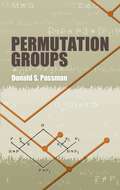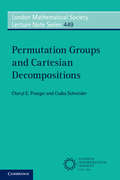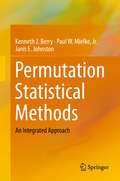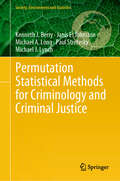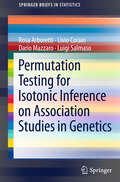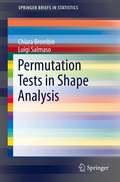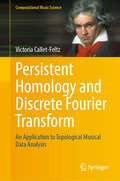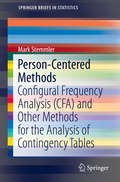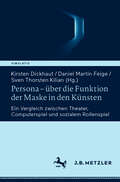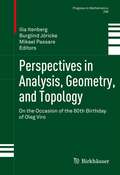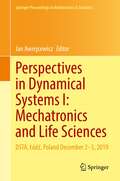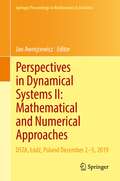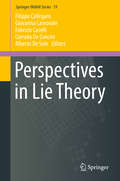- Table View
- List View
Permutation Groups (Dover Books on Mathematics)
by Donald S. PassmanThis volume by a prominent authority on permutation groups consists of lecture notes that provide a self-contained account of distinct classification theorems. A ready source of frequently quoted but usually inaccessible theorems, it is ideally suited for professional group theorists as well as students with a solid background in modern algebra.The three-part treatment begins with an introductory chapter and advances to an economical development of the tools of basic group theory, including group extensions, transfer theorems, and group representations and characters. The final chapter features thorough discussions of the work of Zassenhaus on Frobenius elements and sharply transitive groups in addition to an exploration of Huppert's findings on solvable doubly transitive groups.
Permutation Groups and Cartesian Decompositions (London Mathematical Society Lecture Note Ser. #449)
by Cheryl E. Praeger Csaba SchneiderPermutation groups, their fundamental theory and applications are discussed in this introductory book. It focuses on those groups that are most useful for studying symmetric structures such as graphs, codes and designs. Modern treatments of the O'Nan–Scott theory are presented not only for primitive permutation groups but also for the larger families of quasiprimitive and innately transitive groups, including several classes of infinite permutation groups. Their precision is sharpened by the introduction of a cartesian decomposition concept. This facilitates reduction arguments for primitive groups analogous to those, using orbits and partitions, that reduce problems about general permutation groups to primitive groups. The results are particularly powerful for finite groups, where the finite simple group classification is invoked. Applications are given in algebra and combinatorics to group actions that preserve cartesian product structures. Students and researchers with an interest in mathematical symmetry will find the book enjoyable and useful.
Permutation Statistical Methods
by Kenneth J. Berry Janis E. Johnston Paul W. MielkeThis researchmonograph provides a synthesis of a number of statistical tests and measures,which, at first consideration, appear disjoint and unrelated. Numerouscomparisons of permutation and classical statistical methods are presented, andthe two methods are compared via probability values and, where appropriate,measures of effect size. Permutationstatistical methods, compared to classical statistical methods, do not rely ontheoretical distributions, avoid the usual assumptions of normality andhomogeneity of variance, and depend only on the data at hand. This text takes aunique approach to explaining statistics by integrating a large variety ofstatistical methods, and establishing the rigor of a topic that to many mayseem to be a nascent field in statistics. This topic is new in that it tookmodern computing power to make permutation methods available to people working inthe mainstream of research.
Permutation Statistical Methods for Criminology and Criminal Justice (Society, Environment and Statistics)
by Kenneth J. Berry Janis E. Johnston Michael J. Lynch Michael A. Long Paul StreteskyThis book takes a unique approach to explaining permutation statistical methods for advanced undergraduate students, graduate students, faculty, researchers, and other professionals interested in the areas of criminology or criminal justice. The book integrates permutation statistical methods with a wide range of classical statistical methods. It opens with a comparison of two models of statistical inference: the classical population model espoused by J. Neyman and E. Pearson and the permutation model first introduced by R.A. Fisher and E.J.G. Pitman. Numerous comparisons of permutation and classical statistical methods are illustrated with examples from criminology and criminal justice and supplemented with a variety of R scripts for ease of computation. The text follows the general outline of an introductory textbook in statistics with chapters on central tendency, variability, one-sample tests, two-sample tests, matched-pairs tests, completely-randomized analysis of variance, randomized-blocks analysis of variance, simple linear regression and correlation, and the analysis of goodness of fit and contingency. Unlike classical statistical methods, permutation statistical methods do not rely on theoretical distributions, avoid the usual assumptions of normality and homogeneity, depend solely on the observed data, and do not require random sampling, making permutation statistical methods ideal for analyzing criminology and criminal justice databases. Permutation methods are relatively new in that it took modern computing power to make them available to those working in criminology and criminal justice research. The book contains detailed examples of permutation analyses. Each analysis is paired with a conventional analysis; for example, a permutation test of the difference between experimental and control groups is contrasted with Student's two-sample $t$ test. An added feature is the inclusion of multiple historical notes on the origin and development of both parametric and conventional tests and measures. Designed for an audience with a basic statistical background and a strong interest in parametric and non-parametric statistics, the book can easily serve as a textbook for undergraduate and graduate students in criminology, criminal justice, or sociology, as well as serving as a research source for faculty, researchers, and other professionals in the area of criminology. No statistical training beyond a first course in statistics is required, but some knowledge of, or interest in, criminology or criminal justice is assumed.
Permutation Testing for Isotonic Inference on Association Studies in Genetics
by Livio Corain Luigi Salmaso Rosa Arboretti Dario MazzaroThe purpose of this book is to illustrate a new statistical approach to test allelic association and genotype-specific effects in the genetic study of diseases. There are some parametric and non-parametric methods available for this purpose. We deal with population-based association studies, but comparisons with other methods will also be drawn, analysing the advantages and disadvantages of each one, particularly with regard to power properties with small sample sizes. In this framework we will work out some nonparametric statistical permutation tests and likelihood-based tests to perform case-control analyses to study allelic association between marker, disease-gene and environmental factors. Permutation tests, in particular, will be extended to multivariate and more complex studies, where we deal with several genes and several alleles together. Furthermore, we show simulations under different assumptions on the genetic model and analyse real data sets by simply studying one locus with the permutation test.
Permutation Tests for Complex Data: Theory, Applications and Software (Wiley Series in Probability and Statistics)
by Luigi Salmaso Fortunato PesarinTIMELY UPDATE OF A POPULAR EDITION ON PERMUTATION TESTING WITH NUMEROUS CASE STUDIES INCLUDED THROUGHOUT The newly revised and updated Second Edition of Permutation Tests for Complex Data describes permutation tests from the point of view of experimental design, with methodological details and illustrating the process of devising an appropriate permutation test through case studies. In addition to the text, this book includes two open source packages for permutation tests in Python and R which include a comprehensive code base to implement common permutation tests as well as code to implement each of the book’s case studies. The focus of this book is the permutation approach to a variety of univariate and multivariate problems of hypothesis testing in a typical nonparametric framework. The book examines the most up-to-date methodologies of univariate and multivariate permutation testing, includes real case studies from both experimental and observational studies, and presents and discusses solutions to the most important and frequently encountered real problems in multivariate analyses. Written by two highly qualified authors in the field of nonparametrics and applied statistics, Permutation Tests for Complex Data includes information on sample topics including: Theory of one-dimensional and multi-dimensional permutation tests, covering test statistics, arguments for selecting permutation tests, and examples of one-sample and multi-sample problems Multiplicity control and closed testing, covering raw and adjusted p-values, the MinP Bonferroni-Holm procedure, and weighted methods for controlling FWE and FDR Multivariate categorical variables, covering stochastic ordering, tests on moments for ordered variables, and heterogeneity comparisons NPC tests for survival analysis and shape analysis, covering analysis of PERC data and analysis with correlated landmarks Presenting a thorough overview of permutation testing with both formal description and proofs, Permutation Tests for Complex Data is an excellent introduction to permutation tests for graduate-level statistics or data science courses and will be ideal as a handbook for researchers hoping to use the open source code.
Permutation Tests in Shape Analysis
by Luigi Salmaso Chiara BrombinStatistical shape analysis is a geometrical analysis from a set of shapes in which statistics are measured to describe geometrical properties from similar shapes or different groups, for instance, the difference between male and female Gorilla skull shapes, normal and pathological bone shapes, etc. Some of the important aspects of shape analysis are to obtain a measure of distance between shapes, to estimate average shapes from a (possibly random) sample and to estimate shape variability in a sample[1]. One of the main methods used is principal component analysis. Specific applications of shape analysis may be found in archaeology, architecture, biology, geography, geology, agriculture, genetics, medical imaging, security applications such as face recognition, entertainment industry (movies, games), computer-aided design and manufacturing. This is a proposal for a new Brief on statistical shape analysis and the various new parametric and non-parametric methods utilized to facilitate shape analysis.
Perplexing Paradoxes: Unraveling Enigmas in the World Around Us
by George G. SzpiroWhy does it always seem like the elevator is going down when you need to go up? Is it really true that 0.99999 . . . with an infinite number of 9s after the decimal point, is equal to 1? What do tea leaves and river erosion have in common, per Albert Einstein? Does seeing a bed of red flowers help prove that all ravens are black? Can we make sense of a phrase like “this statement is unprovable”?Exploring these questions and many more, George G. Szpiro guides readers through the puzzling world of paradoxes, from Socratic dialogues to the Monty Hall problem. Perplexing Paradoxes presents sixty counterintuitive conundrums drawn from diverse areas of thought—not only mathematics, statistics, logic, and philosophy but also social science, physics, politics, and religion. Szpiro offers a brisk history of each paradox, unpacks its inner workings, and considers where one might encounter it in daily life. Ultimately, he argues, paradoxes are not simple brain teasers or abstruse word games—they challenge us to hone our reasoning and become more alert to the flaws in received wisdom and common habits of thought.Lighthearted, witty, and conversational, Perplexing Paradoxes presents sophisticated material in an accessible way for all readers interested in the world’s boundless possibilities—and impossibilities.
Persistent Homology and Discrete Fourier Transform: An Application to Topological Musical Data Analysis (Computational Music Science)
by Victoria Callet-FeltzThis book proposes contributions to various problems in the field of topological analysis of musical data: the objects studied are scores represented symbolically by MIDI files, and the tools used are the discrete Fourier transform and persistent homology. The manuscript is divided into three parts: the first two are devoted to the study of the aforementioned mathematical objects and the implementation of the model. More precisely, the notion of DFT introduced by Lewin is generalized to the case of dimension two, by making explicit the passage of a musical bar from a piece to a subset of Z/tZ×Z/pZ, which leads naturally to a notion of metric on the set of musical bars by their Fourier coefficients. This construction gives rise to a point cloud, to which the filtered Vietoris-Rips complex is associated, and consequently a family of barcodes given by persistent homology. This approach also makes it possible to generalize classical results such as Lewin's lemma and Babitt's Hexachord theorem. The last part of this book is devoted to musical applications of the model: the first experiment consists in extracting barcodes from artificially constructed scores, such as scales or chords. This study leads naturally to song harmonization process, which reduces a song to its melody and chord grid, thus defining the notions of graph and complexity of a piece. Persistent homology also lends itself to the problem of automatic classification of musical style, which will be treated here under the prism of symbolic descriptors given by statistics calculated directly on barcodes. Finally, the last application proposes a encoding of musical bars based on the Hausdorff distance, which leads to the study of musical textures. The book is addressed to graduate students and researchers in mathematical music theory and music information research, but also at researchers in other fields, such as applied mathematicians and topologists, who want to learn more about mathematical music theory or music information research.
Person-Centered Methods
by Mark StemmlerThis book takes an easy-to-understand look at the statistical approach called the person-centered method. Instead of analyzing means, variances and covariances of scale scores as in the common variable-centered approach, the person-centered approach analyzes persons or objects grouped according to their characteristic patterns or configurations in contingency tables. The main focus of the book will be on Configural Frequency Analysis (CFA; Lienert and Krauth, 1975) which is a statistical method that looks for over and under-frequented cells or patterns. Over frequented means that the observations in this cell or configuration are observed more often than expected, under-frequented means that this cell or configuration is observed less often than expected. In CFA a pattern or configuration that contains more observed cases than expected is called a type; similarly, a pattern or configuration that is less observed than expected are called an antitype. CFA is similar to log-linear modeling. In log-linear modeling the goal is to come up with a fitting model including all important variables. Instead of fitting a model, CFA looks at the significant residuals of a log-linear model. The book describes the use of an R-package called confreq (derived from Configural Frequency Analysis). The use of the software package is described and demonstrated with data examples.
Person-Centered Methods: Configural Frequency Analysis (CFA) and Other Methods for the Analysis of Contingency Tables (SpringerBriefs in Statistics)
by Mark StemmlerThis book offers a comprehensible overview of the statistical approach called the person-centered method. Instead of analyzing means, variances and covariances of scale scores as in the common variable-centered approach, the person-centered approach analyzes persons or objects grouped according to their characteristic patterns or configurations in contingency tables. This second edition explores the relationship between two statistical methods: log-linear modeling (LLM) and configural frequency analysis (CFA). Both methods compare expected frequencies with observed frequencies. However, while LLM searches for the underlying dependencies of the involved variables in the data (model-fitting), CFA examines significant residuals in non-fitting models. New developments in the second edition include: Configural Mediation Models, CFA with covariates, moderator CFA, and CFA modeling branches in tree-based methods. The new developments enable the use of categorical together with continuous variables, which makes CFA a very powerful statistical tool. This new edition continues to utilize R-package confreq (derived from Configural Frequency Analysis), much updated since the first edition and newly adjusted to the new R base program 4.0. An electronic supplement is now available with 18 R-scripts and many datasets.
Persona – über die Funktion der Maske in den Künsten: Ein Vergleich zwischen Theater, Computerspiel und sozialem Rollenspiel (Simulatio. Theatertechniken in Literatur, Medien und Wissenschaft)
by Daniel Martin Feige Kirsten Dickhaut Sven Thorsten KilianDer Sammelband thematisiert Masken und Maskierungen. Im Vergleich der Künste untersucht er die funktionale Verwendung dieses Theaterrequisits, das eine Technik impliziert, und die Ausgestaltungen von Persona in den Künsten, Maskenverwendungen, -gestaltungen und -problematisierungen, die stets die Produktion von Fiktion und/oder Simulation reflektieren. Zehn Beiträge analysieren Beispiele seit dem 18. Jahrhundert der bildenden Kunst, des Digitalen, des Computerspiels, des Theaters, der erzählenden Literatur und der sozialen Rolle, die jeweils die Maske als Fiktions- oder Simulationsgenerator verstehen, thematisieren und kulturell vergleichend beschreiben. Pirandello stellt dabei grundsätzlich einen wichtigen, aber nicht den einzigen Referenzpunkt dar.
Personal Financial Literacy
by Joan S. RyanLearn how to plan and manage your personal finances, achieve a financially successful life, and take responsibility as a citizen. PERSONAL FINANCIAL LITERACY is aligned with the Jump$tart Coalition's National Standards for Personal Financial Literacy. The personal focus of this course makes it relevant and meaningful to all; in particular, to those just starting down the path to personal financial independence.
Personality Traits and Drug Consumption: A Story Told by Data (SpringerBriefs in Statistics)
by Alexander N. Gorban Jeremy Levesley Elaine Fehrman Vincent Egan Evgeny M. Mirkes Awaz K. MuhammadThis book discusses the psychological traits associated with drug consumption through the statistical analysis of a new database with information on 1885 respondents and use of 18 drugs. After reviewing published works on the psychological profiles of drug users and describing the data mining and machine learning methods used, it demonstrates that the personality traits (five factor model, impulsivity, and sensation seeking) together with simple demographic data make it possible to predict the risk of consumption of individual drugs with a sensitivity and specificity above 70% for most drugs. It also analyzes the correlations of use of different substances and describes the groups of drugs with correlated use, identifying significant differences in personality profiles for users of different drugs. The book is intended for advanced undergraduates and first-year PhD students, as well as researchers and practitioners. Although no previous knowledge of machine learning, advanced data mining concepts or modern psychology of personality is assumed, familiarity with basic statistics and some experience in the use of probabilities would be helpful. For a more detailed introduction to statistical methods, the book provides recommendations for undergraduate textbooks.
Personalized Privacy Protection in Big Data (Data Analytics)
by Shui Yu Youyang Qu Mohammad Reza Nosouhi Lei CuiThis book presents the data privacy protection which has been extensively applied in our current era of big data. However, research into big data privacy is still in its infancy. Given the fact that existing protection methods can result in low data utility and unbalanced trade-offs, personalized privacy protection has become a rapidly expanding research topic.In this book, the authors explore emerging threats and existing privacy protection methods, and discuss in detail both the advantages and disadvantages of personalized privacy protection. Traditional methods, such as differential privacy and cryptography, are discussed using a comparative and intersectional approach, and are contrasted with emerging methods like federated learning and generative adversarial nets.The advances discussed cover various applications, e.g. cyber-physical systems, social networks, and location-based services. Given its scope, the book is of interest to scientists, policy-makers, researchers, and postgraduates alike.
Perspectives in Analysis, Geometry, and Topology
by Mikael Passare Ilia Itenberg Burglind JörickeThe articles in this volume are invited papers from the Marcus Wallenberg symposium and focus on research topics that bridge the gap between analysis, geometry, and topology. The encounters between these three fields are widespread and often provide impetus for major breakthroughs in applications. Topics include new developments in low dimensional topology related to invariants of links and three and four manifolds; Perelman's spectacular proof of the Poincare conjecture; and the recent advances made in algebraic, complex, symplectic, and tropical geometry.
Perspectives in Dynamical Systems I — Applications: DSTA, Łódź, Poland, December 6–9, 2021 (Springer Proceedings in Mathematics & Statistics #453)
by Jan AwrejcewiczThis proceedings volume gathers selected, peer-reviewed papers presented at the Dynamical Systems Theory and Applications International Conference - DSTA 2021, held virtually on December 6-9, 2021, organized by the Department of Automation, Biomechanics, and Mechatronics at Lodz University of Technology, Poland. This volume concentrates on studies on applications, while Volume II focuses on numerical and analytical approaches.Being a truly international conference, this 16th iteration of DSTA received submissions from authors representing 52 countries. The program covered both theoretical and experimental approaches to widely understood dynamical systems, including topics devoted to bifurcations and chaos, control in dynamical systems, asymptotic methods in nonlinear dynamics, stability of dynamical systems, lumped mass and continuous systems vibrations, original numerical methods of vibration analysis, nonsmooth systems, dynamics in life sciences and bioengineering, as well as engineering systems and differential equations.DSTA conferences aim to provide a common platform for exchanging new ideas and results of recent research in scientific and technological advances in modern dynamical systems. Works contained in this volume can appeal to researchers in the field, whether in mathematics or applied sciences, and practitioners in myriad industries.
Perspectives in Dynamical Systems I: DSTA, Łódź, Poland December 2–5, 2019 (Springer Proceedings in Mathematics & Statistics #362)
by Jan AwrejcewiczThis volume is part of collection of contributions devoted to analytical and experimental techniques of dynamical systems, presented at the 15th International Conference “Dynamical Systems: Theory and Applications”, held in Łódź, Poland on December 2-5, 2019. The wide selection of material has been divided into three volumes, each focusing on a different field of applications of dynamical systems.The broadly outlined focus of both the conference and these books includes bifurcations and chaos in dynamical systems, asymptotic methods in nonlinear dynamics, dynamics in life sciences and bioengineering, original numerical methods of vibration analysis, control in dynamical systems, optimization problems in applied sciences, stability of dynamical systems, experimental and industrial studies, vibrations of lumped and continuous systems, non-smooth systems, engineering systems and differential equations, mathematical approaches to dynamical systems, and mechatronics.
Perspectives in Dynamical Systems II — Numerical and Analytical Approaches: DSTA, Łódź, Poland December 6–9, 2021 (Springer Proceedings in Mathematics & Statistics #454)
by Jan AwrejcewiczThis proceedings volume gathers selected, peer-reviewed papers presented at the Dynamical Systems Theory and Applications International Conference - DSTA 2021, held virtually on December 6-9, 2021, organized by the Department of Automation, Biomechanics, and Mechatronics at Lodz University of Technology, Poland. This volume focuses on numerical and analytical approaches, while Volume I concentrates on studies on applications.Being a truly international conference, this 16th iteration of DSTA received submissions from authors representing 52 countries. The program covered both theoretical and experimental approaches to widely understood dynamical systems, including topics devoted to bifurcations and chaos, control in dynamical systems, asymptotic methods in nonlinear dynamics, stability of dynamical systems, lumped mass and continuous systems vibrations, original numerical methods of vibration analysis, non-smooth systems, dynamics in life sciences and bioengineering, as well as engineering systems and differential equations.DSTA conferences aim to provide a common platform for exchanging new ideas and results of recent research in scientific and technological advances in modern dynamical systems. Works contained in this volume can appeal to researchers in the field, whether in mathematics or applied sciences, and practitioners in myriad industries.
Perspectives in Dynamical Systems II: DSTA, Łódź, Poland December 2–5, 2019 (Springer Proceedings in Mathematics & Statistics #363)
by Jan AwrejcewiczThis volume is part of collection of contributions devoted to analytical and experimental techniques of dynamical systems, presented at the 15th International Conference “Dynamical Systems: Theory and Applications”, held in Łódź, Poland on December 2-5, 2019. The wide selection of material has been divided into three volumes, each focusing on a different field of applications of dynamical systems.The broadly outlined focus of both the conference and these books includes bifurcations and chaos in dynamical systems, asymptotic methods in nonlinear dynamics, dynamics in life sciences and bioengineering, original numerical methods of vibration analysis, control in dynamical systems, optimization problems in applied sciences, stability of dynamical systems, experimental and industrial studies, vibrations of lumped and continuous systems, non-smooth systems, engineering systems and differential equations, mathematical approaches to dynamical systems, and mechatronics.
Perspectives in Dynamical Systems III: DSTA, Łódź, Poland December 2–5, 2019 (Springer Proceedings in Mathematics & Statistics #364)
by Jan AwrejcewiczThis volume is part of collection of contributions devoted to analytical and experimental techniques of dynamical systems, presented at the 15th International Conference “Dynamical Systems: Theory and Applications”, held in Łódź, Poland on December 2-5, 2019. The wide selection of material has been divided into three volumes, each focusing on a different field of applications of dynamical systems.The broadly outlined focus of both the conference and these books includes bifurcations and chaos in dynamical systems, asymptotic methods in nonlinear dynamics, dynamics in life sciences and bioengineering, original numerical methods of vibration analysis, control in dynamical systems, optimization problems in applied sciences, stability of dynamical systems, experimental and industrial studies, vibrations of lumped and continuous systems, non-smooth systems, engineering systems and differential equations, mathematical approaches to dynamical systems, and mechatronics.
Perspectives in Lie Theory
by Filippo Callegaro Corrado De Concini Giovanna Carnovale Fabrizio Caselli Alberto De SoleLie theory is a mathematical framework for encoding the concept of symmetries of a problem, and was the central theme of an INdAM intensive research period at the Centro de Giorgi in Pisa, Italy, in the academic year 2014-2015. This book gathers the key outcomes of this period, addressing topics such as: structure and representation theory of vertex algebras, Lie algebras and superalgebras, as well as hyperplane arrangements with different approaches, ranging from geometry and topology to combinatorics.
Perspectives in Sustainable Equity Investing
by Guillaume CoqueretSustainable investing has recently gained traction throughout the world. This trend has multiple sources, which span from genuine ethical concerns to hopes of performance boosting, and also encompass risk mitigation. The resulting appetite for green assets is impacting the decisions of many investors. Perspectives in Sustainable Equity Investing is an up-to-date review of the academic literature on sustainable equity investing. It covers more than 800 academic sources grouped into six thematic chapters. Designed for corporate sustainability and financial management professionals, this is an ideal reference for ESG-driven financiers (both retail and institutional). Students majoring in finance or economics with some background or interest in ESG concerns would also find this compact overview useful. Key Features: Introduces the reader to terms and nomenclature used in the field. Surveys the link between sustainability and performance (including risk). Details the integration of sustainable criteria in complex portfolio optimization. Reviews the financial liabilities induced by climate change.
Perspectives of System Informatics
by Manuel Mazzara Andrei VoronkovThis book constitutes the refereed proceedings of the 10th International Andrei Ershov Informatics Conference, PSI 2015, held in Kazan and Innopolis, Russia, in August 2015. The 2 invited and 23 full papers presented in this volume were carefully reviewed and selected from 56 submissions. The papers cover various topics related to the foundations of program and system development and analysis, programming methodology and software engineering and information technologies.
